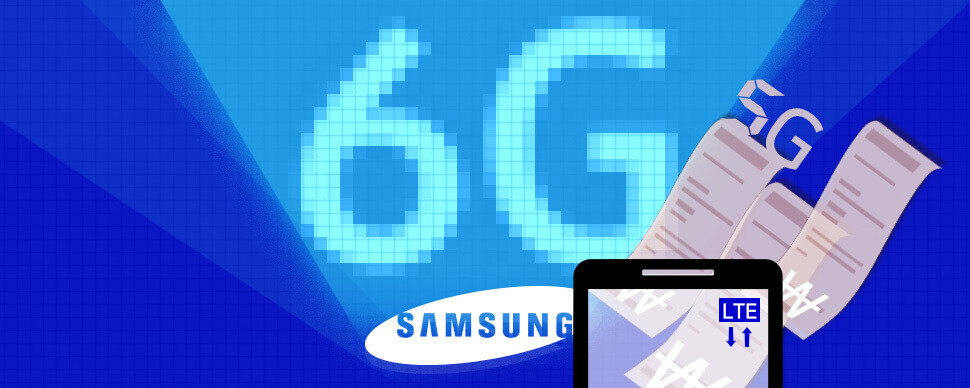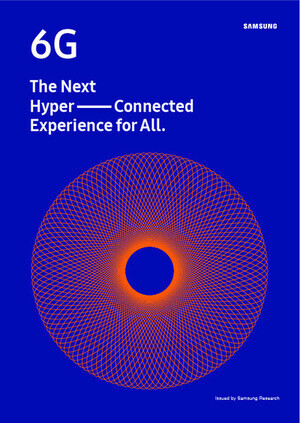hankyoreh
Links to other country sites 다른 나라 사이트 링크
[News analysis] Industry observers puzzle over Samsung’s 6G vision

Technology standardization to begin in 2025. Commercialization by 2028. Popularization by 2030.
Observers in the mobile communications industry have been reacting quizzically to Samsung Electronics’ recent announcement of a vision for 6G communications under the title “A new dimension of superconnectivity experience.” They have been raising the question of whether the company is not getting too far ahead of itself with its 6G vision at a time when 5G technology has not yet reached the stage of popularization. Other observers have been noting that the relationship between 4G (LTE) and 5G/6G is not one of substitution.
As of July 19, a tug-of-war was under way between the telecommunications industry and the South Korean government over the nationwide introduction of 5G services. While discussing the timeline for the nationwide 5G expansion during an industry roundtable organized by the Ministry of Science and ICT (MSIT) on July 3, a senior executive with SK Telecom (SKT) explained, “The reason 4G mobile communications were given the name ‘LTE’ (Long Term Evolution) was to express the idea that they would be in use for a long time.”
“LTE is going to remain the mainstay mobile communications service for some time to come,” the executive added -- suggesting there is no need to be too anxious about taking 5G services nationwide.

Since the commercialization of 4G LTE in July 2011, telecoms have been making further strides in communications technology with “broadband LTE,” “broadband LTE-A,” and “tri-band LTE-A.” Network performance has undergone continued improvements through better digital transmission techniques and the integration of neighboring broadband frequencies, other broadband frequencies, and different tri-band frequencies. Indeed, LTE-A transmission and reception speeds have become twice as fast as LTE’s, while broadband LTE-A and tri-band LTE-A have become three and four times faster.
LTE may main mobile communications service even in 2028In view of this trend, industry analysts are predicting that by 2028 -- which Samsung Electronics set as its 6G commercialization date -- LTE is very likely to still be South Korea’s main mobile communications service, while 5G will be used for “cream skimming,” including special uses or as supplements to LTE in certain regions. Second-generation services (CDMA and PCS) are scheduled to come to an end in June 2021, with the third generation (WCDMA) disappearing a few years later. After that, LTE will be the “veteran” and mainstay telecommunications service. Never mind 6G -- even 5G is seen as unlikely to become a universal service, being used only for a select few consumers and technologies requiring high-capacity communications.
In connection with Samsung Electronics’ 6G vision, telecoms said that technology industries at universities and equipment or service companies may have already begun research to predict 6G’s performance and uses and the sorts of technology it will require. However, the company added that the commercialization and popularization dates are impossible to predict for now.
“After being dealt a blow by China’s Huawei in the 5G competition, Samsung Electronics may start talking about 6G in the sense of a ‘rematch,’” said an official with one telecom.
Announcement in context of Lee Jae-yong’s investigation and trial“But what stands out is the fact that the media are interpreting [Samsung Electronics’ announcement] as reflecting ‘the wishes of [Vice Chairman] Lee Jae-yong,” the official added, suggesting that the significance of the Samsung Electronics announcement is being interpreted in light of Lee being under investigation and trial for corruption.
Operators have continued holding out under pressure from the government and users over increased investment to build communications networks for nationwide 5G services and launch lower-end fee schedules. Some observers have accused the operators of coordinating with the government early on to get their hands on cheap 5G frequencies, only to turn away once their goal had been achieved. The message from telecom CEOs stressing business-to-business (B2B) transactions as the “real opportunity” with 5G also reflects a negative attitude toward the service’s nationwide introduction.
If 5G becomes a supplement to LTE, then makes the 5G subscribers who have changed to more expensive smartphones and paid steep fees over the months into “suckers.” The government, for its part, is likely to be held responsible for building things up. Kim Sang-hee, a Democratic Party lawmaker and deputy speaker of the National Assembly, issued a press release on July 19 in which she noted, “While the number of 5G subscribers is close to 7 million people, their 5G communications network usage times have been less than 15%.”
“We need measures such as a temporary reduction in charges [until quality reaches a level commensurate with subscriber expectations for the 5G fees],” she said.
By Kim Jae-seob, senior staff writer
Please direct comments or questions to [english@hani.co.kr]

Editorial・opinion
![[Column] Season 2 of special prosecutor probe may be coming to Korea soon [Column] Season 2 of special prosecutor probe may be coming to Korea soon](https://flexible.img.hani.co.kr/flexible/normal/500/300/imgdb/original/2024/0426/3317141030699447.jpg) [Column] Season 2 of special prosecutor probe may be coming to Korea soon
[Column] Season 2 of special prosecutor probe may be coming to Korea soon![[Column] Park Geun-hye déjà vu in Yoon Suk-yeol [Column] Park Geun-hye déjà vu in Yoon Suk-yeol](https://flexible.img.hani.co.kr/flexible/normal/500/300/imgdb/original/2024/0424/651713945113788.jpg) [Column] Park Geun-hye déjà vu in Yoon Suk-yeol
[Column] Park Geun-hye déjà vu in Yoon Suk-yeol- [Editorial] New weight of N. Korea’s nuclear threats makes dialogue all the more urgent
- [Guest essay] The real reason Korea’s new right wants to dub Rhee a founding father
- [Column] ‘Choson’: Is it time we start referring to N. Korea in its own terms?
- [Editorial] Japan’s rewriting of history with Korea has gone too far
- [Column] The president’s questionable capacity for dialogue
- [Column] Are chaebol firms just pizza pies for families to divvy up as they please?
- [Column] Has Korea, too, crossed the Rubicon on China?
- [Correspondent’s column] In Japan’s alliance with US, echoes of its past alliances with UK
Most viewed articles
- 1AI is catching up with humans at a ‘shocking’ rate
- 2Korea’s 1.3% growth in Q1 signals ‘textbook’ return to growth, says government
- 3No good, very bad game for Korea puts it out of Olympics for first time since 1988
- 4[Column] Park Geun-hye déjà vu in Yoon Suk-yeol
- 5[Column] Season 2 of special prosecutor probe may be coming to Korea soon
- 6Division commander ordered troops to enter raging flood waters before Marine died, survivor says
- 7Is Japan about to snatch control of Line messenger from Korea’s Naver?
- 8After election rout, Yoon’s left with 3 choices for dealing with the opposition
- 9Will NewJeans end up collateral damage in internal feud at K-pop juggernaut Hybe?
- 10Marriages nosedived 40% over last 10 years in Korea, a factor in low birth rate